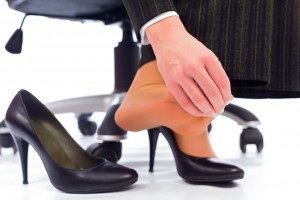Current Methods In Using Electrical Stimulation for Plantar Fasciitis
Plantar Fasciitis Defined:

Plantar Fasciitis is a condition that affects millions of people around the world. It is most often discerned by acute pain in the heel of your feet. The pain is caused by inflammation of a think band of fibrous tissue called the fascia that is used to support the muscles forming the arch of your feet. The fascia reaches along the length of the bottom of your feet from your toes back to the heel. When this fascia tissue gets stretched, long small tears can take place along the surface. These tears become inflamed and cause considerable pain. If you have been diagnosed with “heel spurs” (usually by x-ray), then you are experiencing the buildup of calcium at the end of the fascia tissue where it meets the heel bone (Calcaneus). It is now believed that heel spurs are actually caused by Plantar Fasciitis.
One of the tell-tale signs of Plantar Fasciitis is when you first get out of bed in the morning. During the night, the micro-tears in the fascia begin to heal. When you first step onto a hard floor (without shoes on) in the morning, you can break open the tears again which can then cause intense pain. The pain usually diminishes fairly quickly as the tears are broken open – but the end result is that you have lost all the healing that started during the night.
How did I get Plantar Fasciitis?
Common elements that have been found in patients with Plantar Fasciitis include: excessive weight, long days on your feet, wearing shoes that are worn out or no longer have strong arch support, changing from high-heeled shoes to flat shoes without a period of stretching out the fascia, changing or increasing activity levels that add unusual stress to your feet, suffering from either high arches or flat feet, abnormal gait, or tight Achilles tendons.
How is Plantar Fasciitis Treated?
Current treatments for Plantar Fasciitis include stretching exercises prior to getting out of bed in the morning, wearing bands at night (night splints) that keep your feet stretched out so the micro-tears heal correctly, using a foot roller, using a foot rocker to help stretch your feet, and wearing supportive shoes at all times – even when you are just getting up for a short time. More expensive treatments include off-the-shelf or custom orthotics, steroid injections, and in some cases even surgery. Surgery is usually a last resort as this option includes cutting the plantar fascia from the heel bone. This generally weakens the arch of your foot. Recently, experimental therapy has included extracorporeal shock wave therapy in which sound waves are introduced to break down fibers as a way of increasing blood flow.
Plantar Surface Electrical Stimulation and Using Electrical Stimulation for Plantar Fasciitis
By using low-frequency electrical stimulation for Plantar Fasciitis (EMS or NMES) combined with stretching, doctors have found positive results in reducing the pain from Plantar Fasciitis as well as inducing more rapid healing of the fascia. Electrical stimulation for Plantar Fasciitis will help break up adhesions without impact, strengthen the muscles in your feet, increase the circulation in the stimulated area, and will help promote healing.
Generally with electrical muscle stimulators placement of self-adhesive electrode pads are required on the bottom of your feet. They may also be used on the calf to help stimulate the muscle. With the advent of the Advanced Foot Energizer, you can easily fit the two large plantar surface pads directly to the soles of your feet. It has become much easier and less troublesome to use electrical stimulation for Plantar Fasciitis.
 We recommend using electrical stimulation for plantar fasciitis regularly by placing your feet on the Advanced Foot Energizer and choosing one of it’s low frequency muscle stimulating modes (1-8) for a 25 minute cycle. Use the highest intensity level that remains comfortable for you. The stronger contractions in your feet will increase the therapeutic effect.
We recommend using electrical stimulation for plantar fasciitis regularly by placing your feet on the Advanced Foot Energizer and choosing one of it’s low frequency muscle stimulating modes (1-8) for a 25 minute cycle. Use the highest intensity level that remains comfortable for you. The stronger contractions in your feet will increase the therapeutic effect.
We also recommend using the included body pads on your calf muscles to help condition them as well.
Recommended Reading for Effective Methods of Reducing Plantar Fasciitis Heal Pain.
- Absolute Physical Therapy – Electric Stimulation and Plantar Fasciitis
- Absolute Physical Therapy – Plantar Fasciitis Stretches? Why My Patients Skip
“If the calf muscles are tight we do stretch them, but more importantly we strengthen the all the muscles (intrinsic and extrinsic, including the hips) that support the foot arch with a combination of exercise and EMS. Thus, improving overall fitness while we take the stress off the plantar fascia. Besides strengthening, EMS has the great side effect of immediately reducing pain.”
- Combined neuromuscular electrical stimulation and transcutaneous electrical nerve stimulation for treatment of chronic back pain: a double-blind, repeated measures comparison. Moore SR, Shurman J. – Open PDF
“Combined NMES/TENS treatment consistently produced greater pain reduction and pain relief than placebo, TENS, or NMES. NMES alone, although less effective, did produce as much pain relief as TENS. Although preliminary, this pattern of results suggests that combined NMES/TENS may be a valuable adjunct in the management of chronic back pain.”
I received my unit yesterday and tried it out…all seems to be working. My question is, I have plantar fasciitis and was wondering if there is a certain mode that might help it more than a different mode. Even after one 10 min. session on mode 9 with an intensity setting of 7, I can feel the difference. Just wondering…
Peace,
M